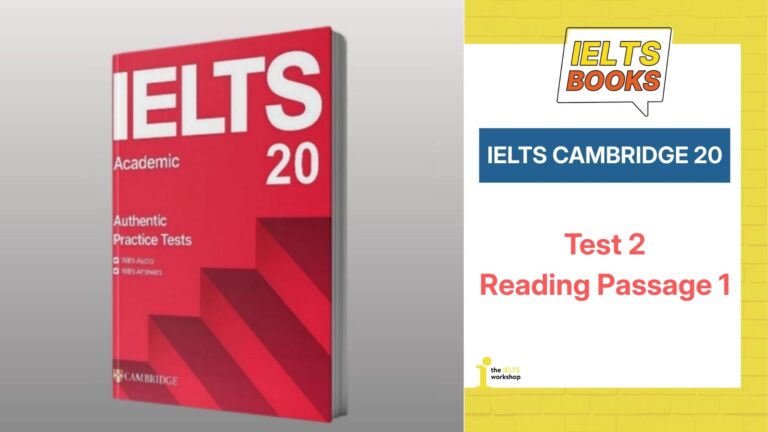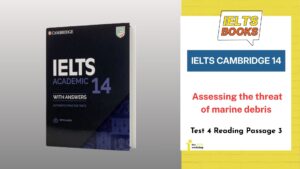Bài viết cung cấp đáp án, Transcript, bản dịch và phân tích chi tiết IELTS Cambridge 20 Test 2 Reading Passage 1 bởi đội ngũ giáo viên uy tín của The IELTS Workshop. Qua bài viết bạn có thể cải thiện kiến thức và kĩ năng làm bài của mình.
Đáp án IELTS Cambridge 20 Test 2 Reading Passage 1
| Câu hỏi | Đáp án |
| 14 | B |
| 15 | F |
| 16 | B |
| 17 | Laziness |
| 18 | Anxious |
| 19 | Threats |
| 20 | Exams |
| 21 | Perfectionists |
| 22 | Guilt |
| 23 | A, C |
| 24 | A, C |
| 25 | A, E |
| 26 | A, E |
Phân tích chi tiết đáp án IELTS Cambridge 20 Test 2 Reading Passage 1
Câu 1 – Đáp án: Tail
Câu hỏi: Appearance – look similar to dugongs, but with a differently shaped _____
(Ngoại hình – trông giống cá cúi, nhưng có hình dạng _____ khác)
Vị trí: Đoạn 1
Transcript: Dugongs and manatees look quite alike – they are similar in size, colour and shape, and both have flexible flippers for forelimbs. However, the manatee has a broad, rounded tail, whereas the dugong’s is fluked, like that of a whale.
Phân tích: Đoạn văn nêu ra sự giống nhau giữa lợn biển (Manatees) và cá cúi (Dugongs) về kích thước, màu sắc, hình dạng và vây trước. Tuy nhiên, điểm khác biệt được nhấn mạnh là lợn biển có đuôi rộng và tròn, trong khi đuôi của cá cúi thì chẻ thùy.
Câu 2 – Đáp án: flippers
Câu hỏi: Movement – need to use their _____ to help to turn their bodies around in order to look sideways.
(Di chuyển – cần sử dụng _____ của chúng để giúp xoay người lại để nhìn sang ngang.)
Vị trí: Đoạn 2
Transcript: Unlike most mammals, manatees have only six bones in their neck – most others, including humans and giraffes, have seven. This short neck allows a manatee to move its head up and down, but not side to side. To see something on its left or its right, a manatee must turn its entire body, steering with its flippers.
Phân tích: Vì lợn biển không thể quay đầu sang hai bên, để nhìn được xung quanh, chúng phải xoay toàn bộ cơ thể và sử dụng các vây (flippers) để điều hướng.
Câu 3 – Đáp án: hairs
Câu hỏi: Movement – sense vibrations in the water by means of _____
(Chuyển động – cảm nhận sự rung động trong nước bằng _____)
Vị trí: Đoạn 2
Transcript: Like elephants, manatees have thick, wrinkled skin. They also have some hairs covering their bodies which help them sense vibrations in the water around them.
Phân tích: Đoạn văn mô tả rằng lợn biển có một số sợi lông trên cơ thể, và chức năng của những sợi lông này là giúp chúng cảm nhận được những rung động trong nước.
Câu 4 – Đáp án: seagrasses
Câu hỏi: Feeding – eat mainly aquatic vegetation, such as _____
(Thức ăn – chủ yếu ăn thực vật thủy sinh, chẳng hạn như _____)
Vị trí: Đoạn 3
Transcript: Seagrasses and other marine plants make up most of a manatee’s diet.
Phân tích: Câu hỏi yêu cầu một ví dụ về thảm thực vật thủy sinh (aquatic vegetation) mà lợn biển ăn. Câu đầu tiên của đoạn văn đã nêu rõ Cỏ biển (Seagrasses) và các loại thực vật biển khác là thành phần chính trong chế độ ăn của chúng.
Câu 5 – Đáp án: lips
Câu hỏi: Feeding – grasp and pull up plants with their _____
(Thức ăn – nắm và kéo cây lên bằng _____ của chúng)
Vị trí: Đoạn 4
Transcript: Instead of having incisors to grasp their food, manatees have lips which function like a pair of hands to help tear food away from the seafloor.
Phân tích: Đoạn văn giải thích rằng thay vì dùng răng cửa, lợn biển sử dụng đôi môi (lips) của mình, hoạt động như một đôi tay để ngoạm và kéo thức ăn.
Câu 6 – Đáp án: buoyancy
Câu hỏi: Breathing – may regulate the _____ of their bodies by using muscles of diaphragm to store air internally
(Thở – có thể điều chỉnh _____ của cơ thể bằng cách sử dụng các cơ hoành để lưu trữ không khí bên trong)
Vị trí: Đoạn 5
Transcript: It’s thought that manatees use their muscular diaphragm and breathing to adjust their buoyancy.
Phân tích: Đoạn văn cho biết người ta tin rằng lợn biển sử dụng cơ hoành và hơi thở để điều chỉnh (adjust) sức nổi (buoyancy) của cơ thể chúng.
Câu 7 – Đáp án: TRUE
Câu hỏi: West Indian manatees can be found in a variety of different aquatic habitats.
(Lợn biển Tây Ấn có thể được tìm thấy ở nhiều môi trường sống dưới nước khác nhau.)
Vị trí: Đoạn 6
Transcript: There are two subspecies of West Indian manatee: the Antillean manatee is found in waters from the Bahamas to Brazil, whereas the Florida manatee is found in US waters… it takes refuge in naturally and artificially warmed water, such as at the warm-water outfalls from power plants.
Phân tích: Đoạn văn mô tả lợn biển Tây Ấn sống ở nhiều khu vực khác nhau (từ Bahamas đến Brazil, vùng biển Hoa Kỳ) và có thể trú ẩn ở cả vùng nước ấm tự nhiên và nhân tạo. Điều này khẳng định chúng có thể được tìm thấy trong nhiều môi trường sống dưới nước đa dạng.
Câu 8 – Đáp án: NOT GIVEN
Câu hỏi: The Florida manatee lives in warmer waters than the Antillean manatee.
(Loài lợn biển Florida sống ở vùng nước ấm hơn loài lợn biển Antillean.)
Vị trí: Đoạn 6
Transcript: In winter, the Florida manatee is typically restricted to Florida. When the ambient water temperature drops below 20°C, it takes refuge in naturally and artificially warmed water…
Phân tích: Đoạn văn có đề cập đến nhiệt độ nước mà lợn biển Florida trú ẩn (dưới 20°C), nhưng hoàn toàn không cung cấp thông tin nào về nhiệt độ nước nơi lợn biển Antillean sinh sống. Do đó, không thể so sánh được.
Câu 9 – Đáp án: FALSE
Câu hỏi: The African manatee’s range is limited to coastal waters between the West African countries of Mauritania and Angola.
(Phạm vi phân bố của loài lợn biển châu Phi chỉ giới hạn ở vùng nước ven biển giữa các quốc gia Tây Phi là Mauritania và Angola.)
Vị trí: Đoạn 7
Transcript: The African manatee is also about 3.5 metres long and found in the sea along the west coast of Africa… The species also makes use of rivers, with the mammals seen in landlocked countries such as Mali and Niger.
Phân tích: Câu hỏi nói rằng phạm vi của lợn biển châu Phi bị giới hạn ở vùng nước ven biển. Tuy nhiên, đoạn văn khẳng định rằng loài này cũng sống ở các con sông và thậm chí được tìm thấy ở các quốc gia không giáp biển. Thông tin này trái ngược với câu hỏi.
Câu 10 – Đáp án: NOT GIVEN
Câu hỏi: The extent of the loss of Amazonian manatees in the mid-twentieth century was only revealed many years later.
(Mức độ mất mát của loài lợn biển Amazon vào giữa thế kỷ XX chỉ được tiết lộ nhiều năm sau đó.)
Vị trí: Đoạn 8
Transcript: It is estimated that 140,000. Amazonian manatees were killed between 1935 and 1954…
Phân tích: Đoạn văn cung cấp ước tính về số lượng lợn biển Amazon bị giết trong giữa thế kỷ 20. Tuy nhiên, không có thông tin nào cho biết thời điểm con số này được công bố hay liệu nó có được tiết lộ “nhiều năm sau đó” hay không.
Câu 11 – Đáp án: TRUE
Câu hỏi: It is predicted that West Indian manatee populations will fall in the coming decades.
(Người ta dự đoán rằng quần thể lợn biển Tây Ấn sẽ giảm trong những thập kỷ tới.)
Vị trí: Đoạn 9
Transcript: The two subspecies of West Indian manatee are listed as Endangered by the IUCN. Both are also expected to undergo a decline of 20% over the next 40 years.
Phân tích: Câu hỏi nói rằng quần thể lợn biển Tây Ấn được dự đoán sẽ suy giảm. Đoạn văn khẳng định rằng cả hai phân loài của chúng đều được “dự kiến sẽ suy giảm 20% trong 40 năm tới”. Thông tin này hoàn toàn khớp với nhau.
Câu 12 – Đáp án: NOT GIVEN
Câu hỏi: The risk to manatees from entanglement and plastic consumption increased significantly in the period 2009-2020.
(Nguy cơ mắc kẹt và tiêu thụ nhựa ở loài lợn biển tăng đáng kể trong giai đoạn 2009-2020.)
Vị trí: Đoạn 9
Transcript: A review of almost 1,800 cases of entanglement in fishing nets and of plastic consumption among marine mammals in US waters from 2009 to 2020 found that at least 700 cases involved manatees.
Phân tích: Đoạn văn cung cấp số liệu tổng hợp về các vụ việc trong giai đoạn 2009-2020 nhưng không đưa ra bất kỳ sự so sánh nào để cho thấy rủi ro này đã “tăng lên đáng kể” trong khoảng thời gian đó. Nó chỉ đưa ra một con số tổng kết.
Câu 13 – Đáp án: TRUE
Câu hỏi: There is some legislation in place which aims to reduce the likelihood of boat strikes on manatees in Florida.
(Có một số luật được ban hành nhằm mục đích giảm khả năng thuyền đâm vào lợn biển ở Florida.)
Vị trí: Đoạn 9
Transcript: The chief cause of death in Florida manatees is boat strikes. However, laws in certain parts of Florida now limit boat speeds during winter, allowing slow-moving manatees more time to respond.
Phân tích: Đoạn văn nêu rõ rằng va chạm với tàu thuyền là nguyên nhân tử vong chính ở lợn biển Florida, và sau đó khẳng định rằng đã có “luật” được ban hành ở Florida để “giới hạn tốc độ tàu thuyền”. Điều này cho thấy có luật pháp được đưa ra để giảm thiểu rủi ro này.
Dịch chi tiết IELTS Cambridge 20 Test 2 Reading Passage 1
Manatees
Manatees, also known as sea cows, are aquatic mammals that belong to a group of animals called Sirenia. This group also contains dugongs. Dugongs and manatees look quite alike – they are similar in size, colour and shape, and both have flexible flippers for forelimbs. However, the manatee has a broad, rounded tail, whereas the dugongs is fluked, like that of a whale. (Q1) There are three species of manatees: the West Indian manatee (Trichechus manatus), the African manatee (Trichechus senegalensis) and the Amazonian manatee (Trichechus inunguis).
Lợn biển, còn được gọi là bò biển, là động vật có vú sống dưới nước thuộc một nhóm động vật gọi là Sirenia (bộ Hải ngưu). Nhóm này cũng bao gồm cá cúi (dugong). Cá cúi và lợn biển trông khá giống nhau – chúng có kích thước, màu sắc và hình dạng tương tự, và cả hai đều có vây trước linh hoạt. Tuy nhiên, lợn biển có đuôi rộng, tròn, trong khi đuôi của cá cúi lại có thùy, giống như đuôi cá voi. Có ba loài lợn biển: lợn biển Tây Ấn (Trichechus manatus), lợn biển châu Phi (Trichechus senegalensis) và lợn biển Amazon (Trichechus inunguis).
Từ vựng cần nhớ:
- Aquatic /əˈkwætɪk/ (tính từ): Sống dưới nước, thuộc về nước.
Unlike most mammals, manatees have only six bones in their neck – most others, including humans and giraffes, have seven. This short neck allows a manatee to move its head up and down, but not side to side. To see something on its left or its right, a manatee must turn its entire body, steering with its flippers (Q2). Manatees have pectoral flippers but no back limbs, only a tail for propulsion. They do have pelvic bones, however – a leftover from their evolution from a four-legged to a fully aquatic animal. Manatees share some visual similarities to elephants. Like elephants, manatees have thick, wrinkled skin. They also have some hairs covering their bodies which help them sense vibrations in the water around them (Q3).
Không giống hầu hết các loài động vật có vú, lợn biển chỉ có sáu đốt sống cổ – hầu hết các loài khác, bao gồm cả con người và hươu cao cổ, đều có bảy. Cái cổ ngắn này cho phép lợn biển di chuyển đầu lên xuống, nhưng không thể qua hai bên. Để nhìn thấy thứ gì đó ở bên trái hoặc bên phải, lợn biển phải xoay toàn bộ cơ thể, điều khiển bằng vây của nó. Lợn biển có vây ngực nhưng không có chi sau, chỉ có đuôi để đẩy. Tuy nhiên, chúng có xương chậu – một di tích từ quá trình tiến hóa từ động vật bốn chân thành động vật hoàn toàn sống dưới nước. Lợn biển có một số điểm tương đồng về hình dáng với voi. Giống như voi, lợn biển có lớp da dày, nhăn nheo. Chúng cũng có một ít lông bao phủ cơ thể giúp chúng cảm nhận được những rung động trong nước xung quanh.
Từ vựng cần nhớ:
- Propulsion /prəˈpʌlʃən/ (danh từ): Lực đẩy, sự đẩy tới
- Evolution /ˌɛvəˈluːʃən/ (danh từ): Sự tiến hóa.
Seagrasses and other marine plants make up most of a manatee’s diet (Q4). Manatees spend about eight hours each day grazing and uprooting plants. They eat up to 15% of their weight in food each day. African manatees are omnivorous – studies have shown that molluscs and fish make up a small part of their diets. West Indian and Amazonian manatees are both herbivores.
Cỏ biển và các loại thực vật biển khác chiếm phần lớn chế độ ăn của lợn biển. Lợn biển dành khoảng tám giờ mỗi ngày để gặm cỏ và nhổ rễ cây. Chúng ăn một lượng thức ăn lên tới 15% trọng lượng cơ thể mỗi ngày. Lợn biển châu Phi là loài ăn tạp – các nghiên cứu đã chỉ ra rằng động vật thân mềm và cá chiếm một phần nhỏ trong chế độ ăn của chúng. Lợn biển Tây Ấn và lợn biển Amazon đều là động vật ăn cỏ.
Từ vựng cần nhớ:
- Omnivorous /ɒmˈnɪvərəs/ (tính từ): Ăn tạp (ăn cả thực vật và động vật)
- Herbivore /ˈhɜːrbɪvɔːr/ (danh từ): Động vật ăn cỏ
Manatees’ teeth are all molars – flat, rounded teeth for grinding food. Due to manatees’ abrasive aquatic plant diet, these teeth get worn down and they eventually fall out, so they continually grow new teeth that get pushed forward to replace the ones they lose. Instead of having incisors to grasp their food, manatees have lips which function like a pair of hands to help tear food away from the seafloor (Q5).
Răng của lợn biển đều là răng hàm – loại răng dẹt, tròn để nghiền thức ăn. Do chế độ ăn thực vật thủy sinh có tính mài mòn, những chiếc răng này bị mòn đi và cuối cùng rụng ra, vì vậy chúng liên tục mọc răng mới được đẩy về phía trước để thay thế những chiếc răng đã mất. Thay vì có răng cửa để ngoạm thức ăn, lợn biển có đôi môi hoạt động như một đôi tay giúp xé thức ăn khỏi đáy biển.
Manatees are fully aquatic, but as mammals, they need to come up to the surface to breathe. When awake, they typically surface every two to four minutes, but they can hold their breath for much longer. Adult manatees sleep underwater for 10-12 hours a day, but they come up for air every 15-20 minutes. Active manatees need to breathe more frequently. It’s thought that manatees use their muscular diaphragm and breathing to adjust their buoyancy. (Q6) They may use diaphragm contractions to compress and store gas in folds in their large intestine to help them float.
Lợn biển hoàn toàn sống dưới nước, nhưng là động vật có vú, chúng cần ngoi lên mặt nước để thở. Khi thức, chúng thường ngoi lên sau mỗi hai đến bốn phút, nhưng chúng có thể nín thở lâu hơn nhiều. Lợn biển trưởng thành ngủ dưới nước 10-12 giờ mỗi ngày, nhưng chúng sẽ ngoi lên lấy hơi sau mỗi 15-20 phút. Lợn biển đang hoạt động cần thở thường xuyên hơn. Người ta cho rằng lợn biển sử dụng cơ hoành và hơi thở để điều chỉnh sức nổi của chúng. Chúng có thể sử dụng các cơn co cơ hoành để nén và tích trữ khí trong các nếp gấp ở ruột già để giúp chúng nổi.
Từ vựng cần nhớ:
- Buoyancy /ˈbɔɪənsi/ (danh từ): Sức nổi, khả năng nổi
- Diaphragm /ˈdaɪəfræm/ (danh từ): Cơ hoành
The West Indian manatee reaches about 3.5 metros long and weighs on average around 500 kilo grammes. It moves between fresh water and salt water, taking advantage of coastal mangroves and coral reefs, rivers, lakes and inland lagoons (Q7). There are two subspecies of West Indian manatee: the Antillean manatee is found in waters from the Bahamas to Brazil, whereas the Florida manatee is found in US waters, although some individuals have been recorded in the Bahamas. In winter, the Florida manatee is typically restricted to Florida. When the ambient water temperature drops below 20°C, it takes refuge in naturally and artificially warmed water, such as at the warm-water outfalls from powerplants (Q8).
Lợn biển Tây Ấn dài khoảng 3,5 mét và nặng trung bình khoảng 500 kilôgam. Nó di chuyển giữa vùng nước ngọt và nước mặn, tận dụng các rừng ngập mặn ven biển và rạn san hô, sông, hồ và các đầm phá nội địa. Có hai phân loài lợn biển Tây Ấn: lợn biển Antillean được tìm thấy ở vùng biển từ Bahamas đến Brazil, trong khi lợn biển Florida được tìm thấy ở vùng biển Hoa Kỳ, mặc dù một số cá thể đã được ghi nhận ở Bahamas. Vào mùa đông, lợn biển Florida thường chỉ giới hạn ở Florida. Khi nhiệt độ nước xung quanh giảm xuống dưới 20°C, nó tìm nơi trú ẩn trong vùng nước được làm ấm tự nhiên và nhân tạo, chẳng hạn như tại các cửa xả nước ấm từ các nhà máy điện.
Từ vựng cần nhớ:
- Subspecies /ˈsʌbˌspiːʃiːz/ (danh từ): Phân loài, loài phụ
- Ambient /ˈæmbiənt/ (tính từ): (Thuộc) môi trường xung quanh
The African manatee is also about 3.5 metros long and found in the sea along the west coast of Africa, from Mauritania down to Angola. The species also makes use of rivers, with the mammals seen in landlocked countries such as Mali and Niger (Q9). The Amazonian manatee is the smallest species, though it is still a big animal. It grows to about 2.5 metros long and 350 kilo grammes. Amazonian manatees favour calm, shallow waters that are above 23°C This species is found in fresh water in the Amazon Basin in Brazil, as well as in Colombia, Ecuador and Peru.
Lợn biển châu Phi cũng dài khoảng 3,5 mét và được tìm thấy ở vùng biển dọc theo bờ biển phía tây châu Phi, từ Mauritania xuống đến Angola. Loài này cũng tận dụng các con sông, với các cá thể được nhìn thấy ở các quốc gia không giáp biển như Mali và Niger. Lợn biển Amazon là loài nhỏ nhất, mặc dù nó vẫn là một loài động vật lớn. Nó phát triển đến chiều dài khoảng 2,5 mét và nặng 350 kilôgam. Lợn biển Amazon ưa thích vùng nước lặng, nông có nhiệt độ trên 23°C. Loài này được tìm thấy ở vùng nước ngọt trong lưu vực sông Amazon ở Brazil, cũng như ở Colombia, Ecuador và Peru.
Từ vựng cần nhớ:
- Landlocked /ˈlændˌlɒkt/ (tính từ): Nằm sâu trong đất liền, không giáp biển
All three manatee species are endangered or at a heightened risk of extinction. The African manatee and Amazonian manatee are both listed as Vulnerable by the International Union for Conservation of Nature (IUCN). It is estimated that 140,000 Amazonian manatees were killed between 1935 and 1954 for their meat, fat and skin (Q10), with the latter used to make leather. In more recent years, African manatee decline has been tied to incidental capture in fishing nets and hunting. Manatee hunting is now illegal in every country the African species is found in.
Cả ba loài lợn biển đều đang bị đe dọa hoặc có nguy cơ tuyệt chủng cao. Lợn biển châu Phi và lợn biển Amazon đều được Liên minh Bảo tồn Thiên nhiên Quốc tế (IUCN) liệt vào danh sách Sắp nguy cấp (Vulnerable). Ước tính có khoảng 140.000 con lợn biển Amazon đã bị giết từ năm 1935 đến năm 1954 để lấy thịt, mỡ và da, trong đó da được dùng để làm đồ da. Trong những năm gần đây hơn, sự suy giảm của lợn biển châu Phi có liên quan đến việc vô tình bị bắt trong lưới đánh cá và bị săn bắn. Săn bắt lợn biển hiện là bất hợp pháp ở mọi quốc gia nơi tìm thấy loài lợn biển châu Phi.
Từ vựng cần nhớ:
- Vulnerable /ˈvʌlnərəbl/ (tính từ): Sắp nguy cấp (một cấp độ trong thang đánh giá của IUCN)
- Incidental /ˌɪnsɪˈdɛntəl/ (tính từ): Ngẫu nhiên, tình cờ, phụ
The two subspecies of West Indian manatee are listed as Endangered by the IUCN. Both are also expected to undergo a decline of 20% over the next 40 years. (Q11) A review of almost 1,800 cases of entanglement in fishing nets and of plastic consumption among marine mammals in US waters from 2009 to 2020 found that at least 700 cases involved manatees. (Q12) The chief cause of death in Florida manatees is boat strikes. However, laws in certain parts of Florida now limit boat speeds during winter, allowing slow-moving manatees more time to respond. (Q13)
Hai phân loài lợn biển Tây Ấn được IUCN liệt vào danh sách Nguy cấp (Endangered). Cả hai cũng được dự kiến sẽ suy giảm 20% trong 40 năm tới. Một đánh giá về gần 1.800 trường hợp vướng vào lưới đánh cá và tiêu thụ nhựa của các loài động vật có vú ở biển trong vùng biển Hoa Kỳ từ năm 2009 đến 2020 cho thấy có ít nhất 700 trường hợp liên quan đến lợn biển. Nguyên nhân tử vong chính ở lợn biển Florida là do va chạm với tàu thuyền. Tuy nhiên, luật pháp ở một số khu vực của Florida hiện đã giới hạn tốc độ tàu thuyền trong mùa đông, giúp những con lợn biển di chuyển chậm có nhiều thời gian hơn để phản ứng.
Từ vựng cần nhớ:
- Entanglement /ɪnˈtæŋɡəlmənt/ (danh từ): Sự vướng vào, mắc vào (lưới)
Series giải đề IELTS Cambridge 20:
- [PDF + Audio] Cambridge IELTS 20: Cập nhật mới nhất (Bản đẹp)
- Đáp án & Lời giải chi tiết Cambridge 20: Test 1 – Test 4
- Giải chi tiết Cambridge 20 Test 1 Listening Part 1:
- Giải chi tiết Cambridge 20 Test 1 Listening Part 2:
- Giải chi tiết Cambridge 20 Test 1 Listening Part 3:
- Giải chi tiết Cambridge 20 Test 1 Listening Part 4:
- Giải chi tiết IELTS Cambridge 20 Test 1 Reading Passage 1:
- Giải chi tiết IELTS Cambridge 20 Test 1 Reading Passage 2:
- Giải chi tiết IELTS Cambridge 20 Test 1 Reading Passage 3:
- [PDF + Audio] Trọn bộ Cambridge Practice Tests For IELTS 1 – 20 mới nhất
Nếu bạn đang tìm kiếm một lộ trình học bài bản, phương pháp rõ ràng và sự đồng hành từ những giảng viên giàu kinh nghiệm, The IELTS Workshop chính là nơi bạn có thể tin tưởng.
Khám phá khóa học IELTS miễn phí tại Website The IELTS Workshop để được trải nghiệm phương pháp học hiện đại, lộ trình cá nhân hóa cùng đội ngũ giảng viên chuyên môn cao ngay nhé!



![[PDF + Audio] Trọn bộ Cambridge Practice Tests For IELTS 1 – 20 mới nhất](https://onthiielts.com.vn/wp-content/uploads/2020/04/cam-1-14-764x400.jpg)
![[PDF + Audio] Cambridge IELTS 20: Cập nhật mới nhất (Bản đẹp)](https://onthiielts.com.vn/wp-content/uploads/2025/07/Cambridge-IELTS-20-300x169.jpg)




